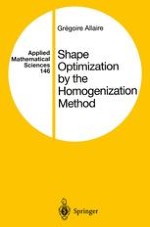
2002 | OriginalPaper | Buchkapitel
Homogenization
verfasst von : Grégoire Allaire
Erschienen in: Shape Optimization by the Homogenization Method
Verlag: Springer New York
Enthalten in: Professional Book Archive
Aktivieren Sie unsere intelligente Suche, um passende Fachinhalte oder Patente zu finden.
Wählen Sie Textabschnitte aus um mit Künstlicher Intelligenz passenden Patente zu finden. powered by
Markieren Sie Textabschnitte, um KI-gestützt weitere passende Inhalte zu finden. powered by
This chapter is a self-contained introduction to the mathematical theory of homogenization. We present all the necessary notions and results of homogenization that will be required for applications in structural optimization. The most general theory in homogenization is that of H-convergence, which was introduced by Spagnolo under the name of G-convergence [260], [261], and further generalized by Tartar [269] and Murat and Tartar [204] as H-convergence. Since it plays a key role in the sequel, it is exposed in great mathematical detail in the context of linear second order elliptic equations (like the conductivity equation or the elasticity system). However, for the less mathematically inclined reader, the first section provides a simpler presentation of what is known as periodic homogenization. This first section is sufficient for those who are ready to accept all the mathematical results of the other sections of this chapter. Let us emphasize that we will not discuss all aspects of H-convergenee. In particular, we shall not touch its application to hyperbolic, parabolic, or nonlinear partial differential equations. Let us also remark that H-convergence is not the only theory in homogenization, although it is, possibly, the most general. There are also a stochastic or probabilistic theory of homogenization (e.g., [118], [154], [215]), and a variational theory of homogenization, known as the Γ-convergence, due to De Giorgi [93], [94], [95] (see also the books [28], [57], [90]).